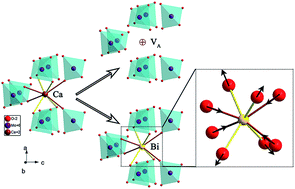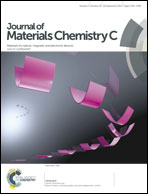Synthesis, structure, and characterization of new low-firing microwave dielectric ceramics: (Ca1−3xBi2xΦx)MoO4†
Abstract
A series of A-site deficient scheelite ceramics (Ca1−3xBi2xΦx)MoO4 (x = 0.005, 0.015, 0.025, 0.035, 0.05, 0.1, 0.15, and 0.2, and Φ: A-site vacancy) were synthesized via the solid state reaction route. The structures were analyzed using a combination of X-ray diffraction and X-ray absorption fine structure spectroscopy (Mo K-edge and Bi L3-edge) to determine average and local structures. A series of defective scheelite (Ca1−3xBi2xΦx)MoO4 compositions can be formed as a solid solution, and local structures of Mo and Bi indicate that a MoO4 tetrahedron and a BiO8 polyhedron become more distorted with the x value. The large change in the Bi–O1 (the first shell) and Bi–O2 (the second shell) distances is an important insight into the nature of the defective structures. The statistical disorder of a Bi–O bond is one order of magnitude larger than that of a Mo–O bond. The microstructures and microwave dielectric properties were investigated by scanning electron microscopy and through network analyzer resonance studies. All the compositions can be sintered well below 900 °C. With slight Bi substitutions (x = 0.005 and 0.015), the samples exhibit improved Q × f values. At x = 0.15, temperature stable (TCF = −1.2 ppm per °C) low-firing (ST = 700 °C) microwave dielectric materials were obtained with a permittivity of 21.2 and a Q × f value of 29 300 GHz. The factors affecting dielectric properties are associated with the local structures of Mo and Bi across the solid solution.


 Please wait while we load your content...
Please wait while we load your content...